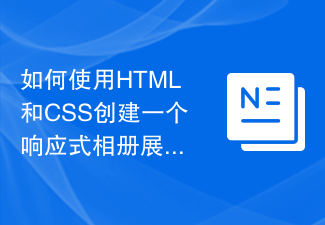The role of responsive layout is to provide a consistent user experience, adapt to diverse devices, reduce development and maintenance workload, improve search engine rankings, improve web page accessibility, future device compatibility, etc. Detailed introduction: 1. Provide a consistent user experience. Responsive layout can enable web pages to be presented in the best way on different devices and screen sizes, thereby providing a consistent user experience, regardless of whether the user is using a desktop computer, laptop, or tablet. Whether it is a computer or a mobile phone, the web page can automatically adjust the layout and content to adapt to different screen sizes and resolutions, etc.

The operating system for this tutorial: Windows 10 system, DELL G3 computer.
Responsive layout plays an important role in modern web design. It has the following important functions:
1. Provide a consistent user experience: Responsive layout can make the web page Optimally present across different devices and screen sizes to provide a consistent user experience. Whether the user is using a desktop computer, laptop, tablet, or mobile phone, web pages automatically adjust layout and content to accommodate different screen sizes and resolutions. This means users will get a similar interface and functionality no matter which device they access the page on, without having to create a separate version of the page for each device. This consistency increases user satisfaction and loyalty.
2. Adapt to diverse devices: With the popularity of mobile devices, users’ needs for accessing web pages on different devices are becoming more and more diverse. Responsive layout allows web pages to flexibly adapt to different devices, whether it is a large-screen desktop computer or a small-screen mobile phone, it can provide a good user experience. This way, users get a similar interface and functionality no matter what device they use, without having to create a separate version of the page for each device.
3. Reduce development and maintenance workload: Responsive layout allows developers to only maintain one web page version instead of creating separate web page versions for each device. This can greatly reduce the development and maintenance workload. When a new device appears, you only need to adjust the CSS style to adapt to the new device without having to recreate a new version of the web page. This saves time and energy and improves development efficiency.
4. Improve search engine rankings: Responsive layout is very beneficial for search engine optimization (SEO). Search engines prefer responsively designed web pages because they provide a consistent user experience and similar content. When users search for relevant content in search engines, search engines are more likely to rank responsively designed web pages higher, thereby increasing the exposure and traffic of the web pages.
5. Improve the accessibility of web pages: Responsive layout can improve the accessibility of web pages, allowing people with disabilities and users with special devices to better access web content. Responsive layouts allow web pages to appear optimally on different devices by automatically adjusting layout and content, providing better accessibility. This helps drive inclusive and accessible web design.
6. Compatibility of future devices: Responsive layout can provide good compatibility for future devices. As technology continues to evolve, new devices and screen sizes are emerging. Responsive layout can maintain good compatibility of web pages by automatically adjusting layout and content to new devices and screen sizes.
In general, responsive layout plays an important role in modern web design. It provides a consistent user experience, adapts to a diverse range of devices, reduces development and maintenance workload, improves search engine rankings, improves web page accessibility, and maintains compatibility with future devices. Through responsive layout, we can provide users with a better web experience and meet the challenges of changing user needs and technological development.
The above is the detailed content of What does responsive layout do?. For more information, please follow other related articles on the PHP Chinese website!
 如何使用HTML和CSS创建一个响应式博客列表布局Oct 21, 2023 am 10:00 AM
如何使用HTML和CSS创建一个响应式博客列表布局Oct 21, 2023 am 10:00 AM如何使用HTML和CSS创建一个响应式博客列表布局在当今的数字时代,博客已经成为了人们分享自己观点和经验的重要平台。而为了吸引更多读者,一个漂亮且响应式的博客列表布局是至关重要的。在本文中,我们将学习如何使用HTML和CSS创建一个简单而又实用的响应式博客列表布局。首先,我们需要准备一些基本的HTML代码。以下是一个简单的博客列表布局的HTML结构:<
 Vue下如何实现高清屏幕适配和响应式布局?Jun 27, 2023 pm 02:31 PM
Vue下如何实现高清屏幕适配和响应式布局?Jun 27, 2023 pm 02:31 PM随着移动互联网的发展,越来越多的设备和屏幕分辨率出现了,如何实现高清屏幕的适配成为每个前端开发人员需要面对的问题。Vue作为一款流行的前端框架,也需要考虑如何适配不同分辨率的屏幕和响应式布局。本文介绍了Vue下如何实现高清屏幕适配和响应式布局的具体方法。一、高清屏幕适配使用ViewportViewport是移动端适配的必备工具,通过Viewport可以指定浏
 如何使用HTML和CSS创建一个响应式博客布局Oct 21, 2023 am 10:54 AM
如何使用HTML和CSS创建一个响应式博客布局Oct 21, 2023 am 10:54 AM如何使用HTML和CSS创建一个响应式博客布局在当今互联网时代,博客已经成为人们分享知识、经验和故事的重要平台。设计一个吸引人且具有响应式布局的博客,可以让你的内容更好地展示在不同尺寸和设备上,提升用户体验。本文将介绍如何使用HTML和CSS来创建一个响应式博客布局,同时提供具体的代码示例。一、HTML结构首先,我们需要搭建博客的基本HTML结构。以下是一个
 CSS布局教程:实现两栏响应式布局的最佳方法Oct 18, 2023 am 11:04 AM
CSS布局教程:实现两栏响应式布局的最佳方法Oct 18, 2023 am 11:04 AMCSS布局教程:实现两栏响应式布局的最佳方法简介:在网页设计中,响应式布局是一种非常重要的技术,它能使网页根据用户设备的屏幕大小和分辨率自动调整布局,提供更好的用户体验。在本教程中,我们将介绍如何使用CSS来实现一个简单的两栏响应式布局,并提供具体的代码示例。一、HTML结构:首先,我们需要创建一个基本的HTML结构,如下所示:<!DOCTYPEht
 如何使用HTML和CSS创建一个响应式相册展示布局Oct 19, 2023 am 08:51 AM
如何使用HTML和CSS创建一个响应式相册展示布局Oct 19, 2023 am 08:51 AM如何使用HTML和CSS创建一个响应式相册展示布局相册展示布局是网站中常见的一种页面布局类型,可以用于展示图片、照片、图像等内容。在今天移动设备普及的环境下,一个好的相册展示布局需要具备响应式设计,能够适应不同尺寸的屏幕,并且在不同设备上具有良好的显示效果。本文将介绍如何使用HTML和CSS来创建一个响应式相册展示布局,并提供具体的代码示例。希望读者能通过示
 Vue实现移动端响应式布局的完整指南(Vant)Jun 09, 2023 pm 04:09 PM
Vue实现移动端响应式布局的完整指南(Vant)Jun 09, 2023 pm 04:09 PMVue实现移动端响应式布局的完整指南(Vant)移动端响应式布局是现代Web开发中非常重要的一环,随着移动设备的普及,如何快速响应用户手机屏幕的大小和分辨率,成为了前端工程师必须面对的挑战之一。Vue框架自带响应式布局的特性,同时也有不少第三方库来帮助我们实现响应式布局。其中,Vant组件库是一款Vue移动端UI库,因其十分强大、易用和定制化,并且完全符合移
 响应式布局为什么不起作用Oct 17, 2023 pm 04:07 PM
响应式布局为什么不起作用Oct 17, 2023 pm 04:07 PM响应式布局不起作用的原因可能是不合理的设计和开发、不充分的测试和优化、复杂的布局需求、性能问题、浏览器和设备兼容性以及特定的体验需求等。详细介绍:1、不合理的设计和开发,响应式布局的成功与否很大程度上取决于设计和开发的质量,如果设计师和开发人员没有充分理解响应式布局的原理和技术,可能会导致布局不正常或无法适应不同的设备,如果没有充分测试和调试,也可能导致响应式布局出现问题等等。
 Vue3+TS+Vite开发技巧:如何进行移动端适配和响应式布局Sep 11, 2023 am 08:25 AM
Vue3+TS+Vite开发技巧:如何进行移动端适配和响应式布局Sep 11, 2023 am 08:25 AM移动互联网的发展进一步推动了移动设备的普及,而作为前端开发者,我们在开发移动端应用程序时,需要考虑到不同尺寸的设备屏幕和不同分辨率的适配问题。本文将介绍如何使用Vue3、TypeScript和Vite进行移动端适配和响应式布局的开发技巧。移动端适配是指根据不同的移动设备屏幕尺寸和分辨率来调整页面元素的布局和样式,以保证页面内容在不同设备上的呈现效果一致。而响

Hot AI Tools

Undresser.AI Undress
AI-powered app for creating realistic nude photos

AI Clothes Remover
Online AI tool for removing clothes from photos.

Undress AI Tool
Undress images for free

Clothoff.io
AI clothes remover

AI Hentai Generator
Generate AI Hentai for free.

Hot Article

Hot Tools

SAP NetWeaver Server Adapter for Eclipse
Integrate Eclipse with SAP NetWeaver application server.

EditPlus Chinese cracked version
Small size, syntax highlighting, does not support code prompt function

Dreamweaver Mac version
Visual web development tools

Notepad++7.3.1
Easy-to-use and free code editor

VSCode Windows 64-bit Download
A free and powerful IDE editor launched by Microsoft






